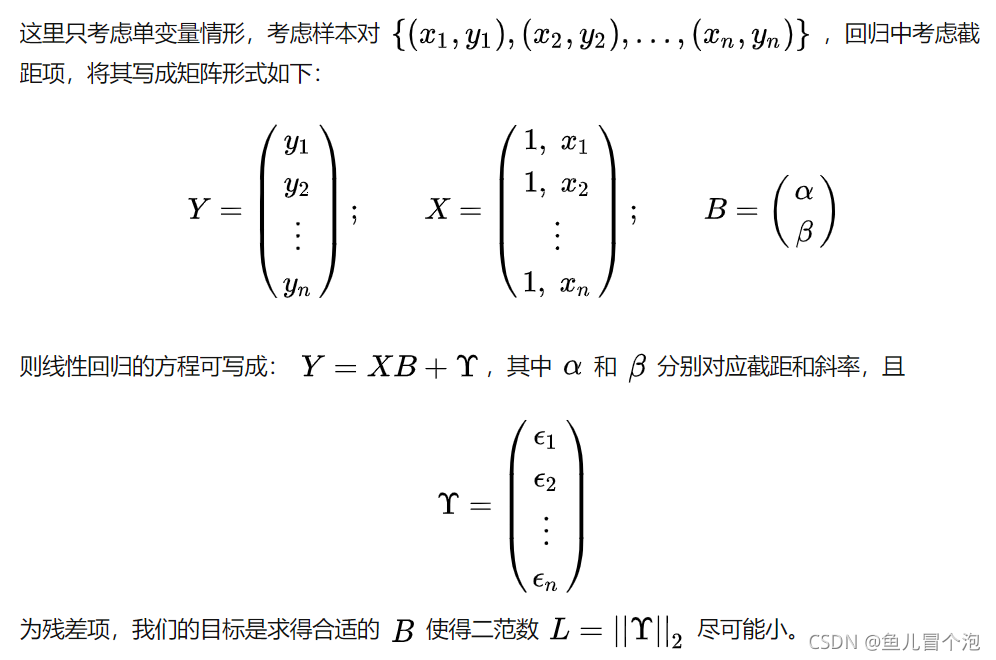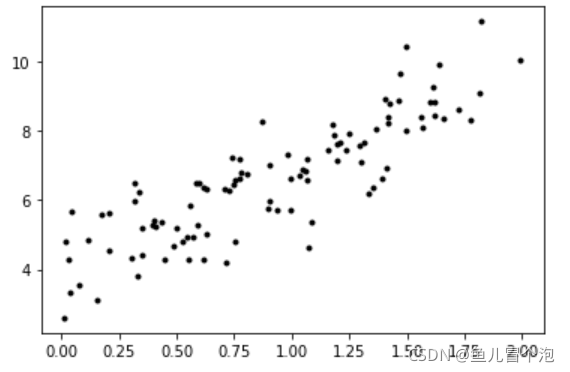线性回归


# an example
import numpy as np
import matplotlib.pyplot as plt
X = 2 * np.random.rand(100, 1)
y = 3 * X + 4 + np.random.randn(100, 1)
plt.plot(X, y, 'k.')
plt.show()

X_b = np.c_[np.ones((100, 1)), X]
theta = np.linalg.inv(X_b.T.dot(X_b)).dot(X_b.T).dot(y)
theta
# array([[3.91711324],
# [2.934259 ]])
使用sklearn进行线性回归:
from sklearn.linear_model import LinearRegression
lin_reg = LinearRegression()
lin_reg. fit(X, y)
lin_reg.intercept_, lin_reg.coef_
# (array([3.91711324]), array([[2.934259]]))
# Scikit-Learn 将偏差项(intercept_)核特征权重(coef_)分开
梯度下降
1、批量梯度下降
计算梯度下降的每一步时,都是基于完整的训练集X
eta = 0.1
n_iterations = 1000
m = 100
theta = np.random.randn(2, 1)
for iteration in range(n_iterations):
gradients = 2/m * X_b.T.dot(X_b.dot(theta) - y)
theta = theta - eta * gradients
theta
# array([[3.91711324],
# [2.934259 ]])
2、随机梯度下降
每一步在训练集中随机选择一个实例,并基于该单个实例计算梯度
当成本函数非常不规则时, 随机梯度下降可以帮助算法跳出局部最小值。相比批量梯度下降,随机梯度下降对寻找全局最小值更有优势。
随机性的好处在于可以逃离局部最优,但是缺点是永远定位不出最小值
解决方法:逐渐降低学习率——模拟退火
n_epochs = 50
t0, t1 = 5, 50 # learning schedule hyperparameters
def learning_schedule(t):
return t0/(t + t1)
theta = np.random.randn(2, 1)
for epoch in range(n_epochs):
for i in range(m):
random_index = np.random.randint(m)
xi = X_b[random_index:random_index + 1]
yi = y[random_index:random_index + 1]
gradients = 2 * xi.T.dot(xi.dot(theta) - yi)
eta = learning_schedule(epoch * m + i)
theta = theta - eta * gradients
theta
# array([[3.97165339],
# [2.94092433]])
使用随机梯度下降时, 训练实例必须保持独立且均匀分布(IID),以确保平均而言将参数拉向全局最优值。确保这一点的一个简单方法时在训练过程中对实例进行随机混洗
使用带有Scikit-Learn的随机梯度下降执行线性回归
from sklearn.linear_model import SGDRegressor
# run until iterations == 1000 or loss < 0.001 (max_iter=1000, tol = 1e-3)
# learning rate = 0.1 (eta0=0.1)
# No ragularization (penalty=None)
sgd_reg = SGDRegressor(max_iter=1000, tol=1e-3, penalty=None, eta0=0.1)
sgd_reg.fit(X, y.ravel())
# rival() : Flatten multidimensional array
sgd_reg.intercept_, sgd_reg.coef_
# (array([4.37064466]), array([2.85664733]))
3、小批量梯度下降
每一步中,不是根据完整的训练集(如批量梯度下降)或仅基于一个实例(如随机梯度下降)来计算梯度
多项式回归
多项式回归:可以用线性模型拟合非线性模型。 将每个特征的幂次方添加为一个新特征, 然后在此拓展训练集上训练一个线性模型
# an example
import numpy as np
import matplotlib.pyplot as plt
m = 100
X = 6 * np.random.rand(m, 1) - 3
y = 0.5 * X**2 + X + 2 + np.random.randn(m, 1)
plt.plot(X, y, 'k.')
plt.show()

from sklearn.preprocessing import PolynomialFeatures
poly_features = PolynomialFeatures(degree=2, include_bias=False)
X_poly = poly_features.fit_transform(X)
X[0], X_poly[0]
# (array([-2.57177719]), array([-2.57177719, 6.61403794]))
from sklearn.linear_model import LinearRegression
lin_reg = LinearRegression()
lin_reg.fit(X_poly, y)
lin_reg.intercept_, lin_reg.coef_
# (array([2.13509276]), array([[1.00195518, 0.50394306]]))
# 模型估算: y = 0.503 * x^2 + 1.002 * x + 2.135